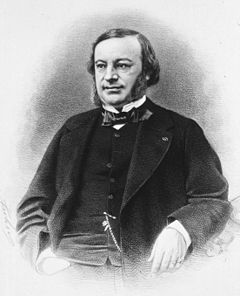Auguste Ambroise Tardieu
| Auguste Ambroise Tardieu | |
|---|---|
 |
|
| Born |
10 March 1818 Paris, France |
| Died | 12 January 1879 (aged 60) |
| Residence | Paris, France |
| Citizenship | French |
| Nationality | French |
| Fields | Forensic science, Public health |
| Institutions | Faculté de Médicine de Paris |
| Known for | Tardieu's syndrome, Tardieu's ecchymoses, First forensic studies of child maltreatment |
| Influenced | Paul Brouardel |
| Notable awards | Prize of the French Academy of Science (1875) |
Auguste Ambroise Tardieu (10 March 1818 – 12 January 1879) was a French medical doctor and the pre-eminent forensic medical scientist of the mid-19th century.
The son of artist and mapmaker Ambroise Tardieu, he achieved his Doctorate in Medicine at the Faculté de Médecine of Paris. He was President of the French Academy of Medicine, as well as Dean of the Faculty of Medicine and Professor of Legal Medicine at the University of Paris.
Tardieu's specialties were forensic medicine and toxicology. Over his 23-year career, Tardieu participated as a forensic expert in 5,238 cases, including many famous and notorious historical crimes. Using his cases as a statistical base, Tardieu wrote over a dozen volumes of forensic analysis, covering such diverse areas as abortion, drowning, hanging, insanity, homosexuality, poisoning, suffocation, syphilis, and tattoos.
In recognition of his first clinical descriptions of battered children, battered child syndrome is also known as Tardieu's syndrome.
Tardieu's ecchymoses, subpleural spots of ecchymosis that follow the death of a newborn child by strangulation or suffocation, were first described by Tardieu in 1859, and were so named in his honor.
His most famous scientific works were a book on forensic toxicology that became a reference work in this field in the 19th century, and a book on the forensic examinations related to ”assault on decency”, a legal term covering indecent exposure, rape and homosexuality. He also wrote a pioneering study on maltreatment against children and he published on the terrible working conditions of young boys and girls in mines and factories. A study of copper workers (both child and adult) led to a radical improvement in their working conditions.
Though Tardieu’s textbook on the legal medicine of poisoning was the work that did most to establish him as an authority in his time, for the posterity he is most famous for his forensic study of sexual crimes: Etude Médico-Légale sur les Attentats aux Mœurs The study consists of three parts: the first deals with indecent exposures, the second with rape and the third with "pederasty" (sexual relations between an older and a younger man). This third part is considered a classic study in the history of homosexuality. Written before the term homosexuality was coined, Tardieu sought to identify external signs of committed ”pederasty” which may help the forensic expert present convincing evidence that a crime had been committed to the court of law. In so doing, Tardieu discussed the causes of homosexuality, without making them the main purpose of his study. He presumed some of the ”pederasts” had an inborn inclination, but nevertheless considered the sexual practice in question to be a condemnable vice. According to Tardieu same-sex sexuality was often linked to crime, such as blackmailing and assassinations. The book was an important precursor to Krafft-Ebing’s Psychopathia sexualis, the most famous pre-freudian study on same-sex sexual practices. For the modern reader this work is an important historical document, particularly valuable for the cultural history of sexuality by the glimpses it gives into some of the secret sexual cultures of his time.
...
Wikipedia
